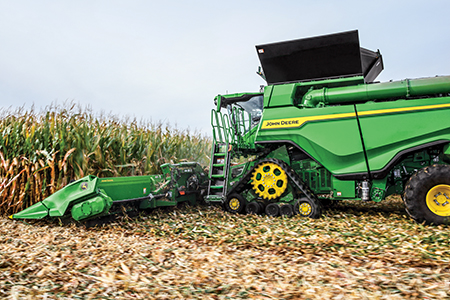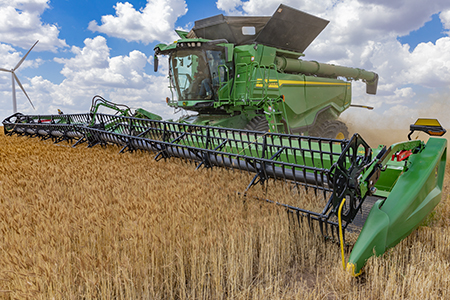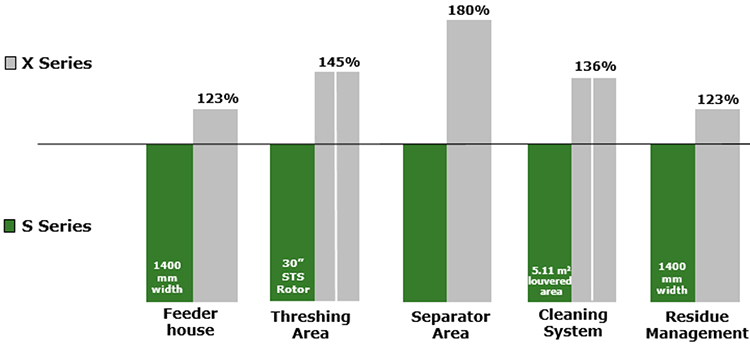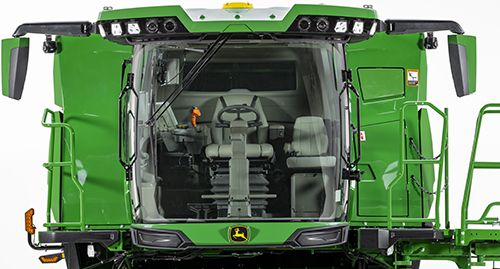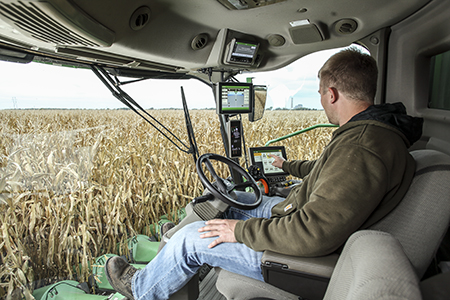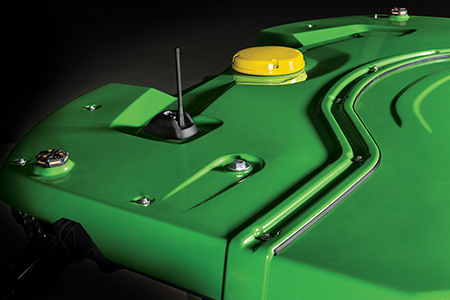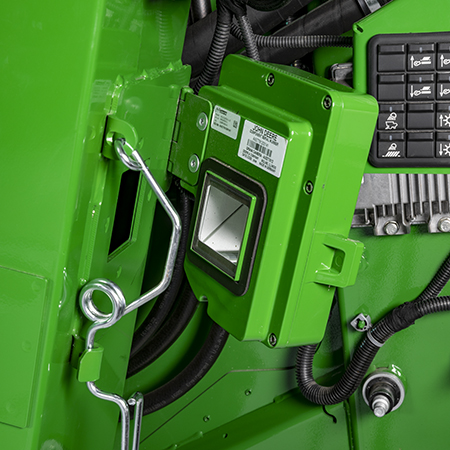 X9 1100, PAMI storage band and collector
X9 1100, PAMI storage band and collector
Combine capacity, time, and money - what are they worth to you? In late September and early October of 2020, John Deere contracted PAMI (Prairie Agricultural Machinery Institute) to conduct independent benchmarking of the John Deere X9 1100 Combine versus the CLAAS 8800 Combine. PAMI tested these combines in tough wheat and canola conditions in Western Canada, and what they found was impressive. Read the full PAMI reports at www.pami.ca/publications.
Capacity
In 102 bu/acre wheat, PAMI found the X9 1100 Combine had a 28 percent capacity advantage over the CLAAS 8800 at a 1 percent total loss threshold (figure 10 of the PAMI report). Considering a farm with 8,000 acres of wheat, here is a breakdown of how a John Deere X9 Combine would compare to a CLAAS 8800 when harvesting wheat at 1 percent loss:
Harvesting wheat at 1 percent loss |
X9 1100 |
CLAAS 8800 |
X9 1100
advantage |
|
Total throughput (tonnes/hr) |
115 |
90 |
25 |
More tonnes/hr |
Combine capacity (bu/hr) |
2,306 |
1,801 |
505 |
More bu/hr |
Productivity (acres/hr) |
18 |
14 |
4 |
More acres/hr |
Productivity (acres/14-hour day) |
253 |
198 |
55 |
More acres/day |
Machine depreciation (dollars/acre) |
$19.75 |
$25.28 |
$5.53 |
Savings per acre |
Operator cost at $30/hr (dollars/acre) |
$18,960 |
$24,270 |
$0.66 |
Savings per acre |
Total fleet value depreciation |
$157,997 |
$202,238 |
$44,241 |
In depreciation saved |
Days of harvest needed (14-hour days) with two machines |
22.57 |
28.89 |
6.3 |
Fewer harvest days |
Time and money
With a John Deere X9 Combine, you can simply harvest more acres in less time and with less grain loss. In fact, as you can calculate from the PAMI testing results, the X9 Combine can save you 6.3 total harvest days when compared to the CLAAS 8800 in a two-machine harvest scenario. This is essentially a week of time saved in the field with your combines. A lot can happen in one week, including rain storms that reduce your wheat’s test weight or snow storms that can prolong your harvest and make for very difficult harvesting conditions in the future. An X9 combine helps you manage this risk by enabling a faster and cost-saving wheat harvest, so you can get into other crops such as canola and pulses much earlier.
In addition to getting your crop out of the field faster, an X9 Combine also directly saves you money by requiring less time to do the same amount of work. The X9 can save you $0.66 per acre in operator time and $5.53 per acre in depreciation savings, for a total savings of up to $6.19 per acre when running at 1 percent loss.
Everything discussed until this point has been at a 1 percent loss rate. Let’s say storms are in the forecast and you need to get your wheat crop off the field as fast as possible. An X9 Combine is up to that task as well. When PAMI tested both machines to a power limit condition (figure 10 of the PAMI wheat report), here’s what they found:
Harvesting wheat at power limit |
X9 1100 |
CLAAS 8800 |
X9 1100
advantage |
|
Grain loss (percent/acre) |
2 |
6 |
4 |
Percent less loss per acre |
Grain loss value (dollars/acre) |
$12.04 |
$36.11 |
$24.07 |
Savings per acre |
At power limit, the X9 1100 never exceeded 2 percent loss, and the CLAAS 8800 reached a 6 percent loss rate. When you need to get your crop off the field as fast as possible, the X9 can save you up to $24.07 per acre compared to the CLAAS 8800. Additionally, more available power would not have helped the CLAAS 8800 close this gap, since the 8800’s loss rate was already increasing at a higher rate compared to the X9 1100. If rain or snow is in the forecast or if you are short on time, an X9 Combine can deliver outstanding performance in tough conditions as demonstrated in the results of the PAMI testing.
Canola harvesting
Harvesting canola |
X9 1100 |
CLAAS 8800 |
X9 1100
advantage |
|
Total throughput (tonnes/hr) at 3 percent loss |
63 |
63 |
Equal |
Tonnes/hr |
Total capacity (bu/hr) at 3 percent loss |
1,152 |
1,152 |
Equal |
bu/hr |
Maximum throughput achieved (tonnes/hr) |
89 |
73 |
16 |
More tonnes/hr |
Fuel consumption (gal./100 bu) |
1.96 |
2.38 |
18 |
Percent less fuel per bushel |
When PAMI tested the machines in canola, both machines performed well in tough conditions. Each machine reached a total throughput of 63 tonnes/hr or 1,152 bu/hr at a 3 percent loss rate. However, the X9 1100 used 18 percent less fuel per bushel harvested than the CLAAS 8800 in these tests. When you consider this on a farm with 4,000 acres of canola, you’d save over 1,227 gal. of fuel or $0.79 per acre. PAMI also mentions that machine noise and distress were limiting factors on how hard the machines could be pushed in these conditions, and the X9 1100 could be ran at a higher throughput (see figure 10 of the PAMI canola report). This again speaks to the performance of X9 Combines when needing to harvest in the toughest conditions.
Summary
More acres in less time and with less cost is what the independent PAMI benchmarking results prove you get when you purchase a John Deere X9 Combine. Reach out to your John Deere dealer to learn more about how the X9 Combine can help you be more successful in your operation.
Assumptions
The examples provided here are based on the yields and conditions where the independent PAMI benchmarking took place. Actual values will vary depending on your conditions, yields, machine count, and operational efficiencies. Here is a summary of the values used:
- All $ amounts are in U.S. dollars
- 8,000 acres of wheat
- 102 bu/acre for wheat yield
- $5.90 per bushel for wheat
- 4000 acres of canola
- 72 bu/acre for canola yield
- $11.60 canola per bushel
- $2.10 per gallon for diesel
- Machine depreciation and total fleet depreciation are based on a $250 per engine hour reduction in value. It should be noted that different rates may be experienced in the market. This rate is for this example only.
- 0.8 field efficiency factor
- One harvest day assumes a 14 engine hour day with a 0.7 separator hour-to-engine hour ratio
CLAAS is a trademark of CLAAS KGaA mbH.


